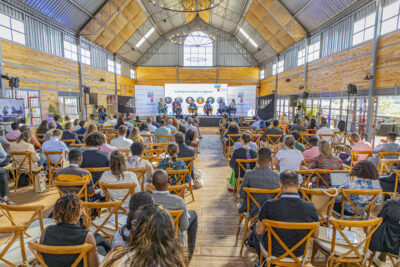News
How do we ‘do’ impact networks? In a previous post we shared why Small Foundation supports impact networks. In this post we will explore our experience of what an impact network approach entails, including how impact networks differ from organisations.
Impact networks provide a process for engagement that can guide the connection and collaboration of motivated actors – multiple and varied stakeholders – to address complex problems together. It is often not clear what will emerge from collaborative processes and so there needs to be space for learning, adaptation and emergent outcomes.
To hold and make sense of this complexity, Converge – our network learning partner – have developed a roadmap for how a network can be formed and progressed. The Converge approach is called the five Cs:
- Clarify purpose and principles
- Convene the people
- Cultivate trust
- Coordinate actions
- Collaborate for systems change
From the outset, a key differentiator of impact networks is that they are focused on a common purpose. By placing a common purpose at the heart of their existence, impact networks ensure that this purpose – a complex problem or system change – becomes their driving rationale and focus.
In contrast, organisations often exist to advance their own goals and are working towards the sustainability of the organisation to achieve those goals, often measured by growth in the form of increased number of employees and increasing annual turnover. If they do collaborate, organisations will typically retain their own operational interests as a key driver; indeed, their governance systems may require this. Without a common purpose at the centre these practical considerations make building the relationships needed for effective and sustained collaboration difficult.
In impact networks the purpose is co-created by the network members and is therefore co-owned by the participants. Members are in the network because they have self interest in achieving the common purpose and the network provides a way to engage with other stakeholders, even if they are coming from different perspectives.
As an example, one of Small Foundation’s network partners is the Agribusiness Market Ecosystem Alliance (AMEA), a global network whose goal is accelerating the professionalisation of farmer organisations. Prior to formation of the network, AMEA’s 24 members and eight strategic partners were each working independently towards this shared goal. Instead of continuing to run hundreds of projects to deliver services in a fragmented, expensive and unsustainable way, AMEA members came together to work towards a common, systems-level purpose. Today AMEA works towards achieving a changed support system that accelerates farmer organisation professionalisation and incentivises service quality improvement.
Once the network has a purpose it can get to work on ensuring that the right people are in the room and the relationships between the network participants and members thrive and flourish. While it is not always necessary to like or agree with other members of the network, it is essential that social capital grows across the network over time to accelerate effective connection. Trust is everything.
Once trust is established between members there becomes potential for coordination of information and actions. Over time we believe this can and will lead to collaboration.
We have seen the power of trust in Small Foundation’s network partner the Council on Smallholder Agricultural Finance (CSAF), a group of 16 social lenders focused on smallholder finance globally. Since inception in 2012, they have built trust between members through convenings to share learning, develop industry standards and best practices, and engage other stakeholders to address barriers to market growth and impact. Their coordination and collaboration has included field building contributions such as their annual State of the Sector report and benchmarking studies.
The five Cs is a process and journey that needs coordination and support. What does effective coordination looks like? How, concretely, do you build trust? We will explore our learning and experience on these issues in future posts.
Making impact networks work is not easy or straightforward. Converge’s five Cs framework has served us well in exploring how we can best support our impact network partners. There is always risk when supporting emergent outcomes, but the rewards are high. The complex challenges facing the global community make collaboration for system-level change an imperative.
Small Foundation has developed our network practice in partnership with Converge. You can sign up for their newsletter and read more about the ideas in this post at Converge. We are delighted that David Ehrlichman will publish a comprehensive book about Converge’s impact network approach later this year.




